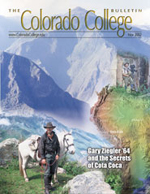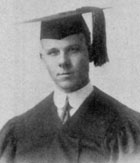
| NOVEMBER 2002 |
The Untold Story of Chaplain Thomas Kirkpatrick:
Symbol of Pearl Harbor
By Edward Goldstein '79 “This war is a new kind of war. It is different from all other
wars of the past, not only in its methods and weapons but also
in its geography.” So said the president of the United States
following the devastating aerial assault that left thousands
of unsuspecting Americans suddenly dead. The president, of course,
was Franklin D. Roosevelt, and the event that sparked these
comments occurred at Pearl Harbor 60 years ago on a quiet Sunday
morning in the territory of Hawaii.
“This war is a new kind of war. It is different from all other
wars of the past, not only in its methods and weapons but also
in its geography.” So said the president of the United States
following the devastating aerial assault that left thousands
of unsuspecting Americans suddenly dead. The president, of course,
was Franklin D. Roosevelt, and the event that sparked these
comments occurred at Pearl Harbor 60 years ago on a quiet Sunday
morning in the territory of Hawaii.September 11, 2001 has now joined the pantheon of days “which will live in infamy.” Along with December 7, 1941, it is one of two days in our history in which surprise attacks from the air have in an instant horrified and galvanized our people.
 Because the events of September 11 were broadcast in real time
and subsequently reported by the scores of East Coast-based
media members, the public knows a great deal about the victims
of the terrorist attacks. Some victims, like Father Mychal Judge,
the New York City Fire Department chaplain, have become recognized
throughout the world as symbols of the nearly 4,000 lives lost
in the attacks.
Because the events of September 11 were broadcast in real time
and subsequently reported by the scores of East Coast-based
media members, the public knows a great deal about the victims
of the terrorist attacks. Some victims, like Father Mychal Judge,
the New York City Fire Department chaplain, have become recognized
throughout the world as symbols of the nearly 4,000 lives lost
in the attacks.If Pearl Harbor had been reported by today’s media, perhaps one of the victims who would come to symbolize that tragedy might have been another man of the cloth, Navy Chaplain Thomas Leroy Kirkpatrick, a graduate of Colorado College.
I came across Kirkpatrick’s name last October while thumbing through a 1945 edition of the Nugget, Colorado College’s yearbook, while on a visit to the campus for Homecoming activities. Still stunned by the events of September 11, I was curious as to how students of my alma mater experienced the trying events of their time.
As reported by the Nugget, Capt. Kirkpatrick was one of 32 CC graduates who died in World War II service. Seeing the date and circumstances of Kirkpatrick’s death, I vowed to learn more about his life’s story.
Kirkpatrick was born on July 5, 1887, in Cozad, Neb., a boomtown along the Platte River that was founded 15 years prior when the Union Pacific Railroad was promoting settlement along its westward lines. His family later moved to Colorado Springs, which was then undergoing an economic boom following the 1891 discovery of gold near Cripple Creek.
Having graduated from Colorado Springs High School in 1905, Kirkpatrick went on to attend Colorado College. While at CC, he appeared twice in the student yearbook. In one photo, Kirkpatrick looks like a confident young Woodrow Wilson, wearing proper coat and tie. His nickname was “Kirk” and his motto was “Nothing is so popular as goodness.” In 1911, the statement “I have digged and drunk water,” was placed next to his graduation photo. It was noted that he was president of the Student Volunteer Band; vice president of Pearsons Literary Society; assistant editor of the Tiger, CC’s newspaper; and general secretary of the YMCA. In short, he was a comer.
From the history of Navy chaplains, obtained through the National Archives, I found out that Kirkpatrick graduated from McCormick Theological Seminary in Chicago in 1918 with a bachelor of divinity degree and joined the Navy six days later. He married Genevieve M. Burnet in 1923 and had one child, a son born in 1932.
 As Kirkpatrick was beginning to embark on his clerical career,
the United States was several months into the “War to End all
Wars.” And the United States Navy, which at the time the U.S.
declared war on Germany on April 6, 1917, had only 40 chaplains
on active duty, was gearing up to handle the spiritual needs
of the men who rushed to heed Uncle Sam’s call. The Navy commissioned
107 chaplains in Kirkpatrick’s class of 1918.
As Kirkpatrick was beginning to embark on his clerical career,
the United States was several months into the “War to End all
Wars.” And the United States Navy, which at the time the U.S.
declared war on Germany on April 6, 1917, had only 40 chaplains
on active duty, was gearing up to handle the spiritual needs
of the men who rushed to heed Uncle Sam’s call. The Navy commissioned
107 chaplains in Kirkpatrick’s class of 1918.Kirkpatrick immediately went “over there” to the front in France, where the presence of the American Expeditionary Force was beginning to alter the balance of forces on the ground in favor of the Western democracies. During this period, Kirkpatrick was among six Navy chaplains who had shore duty.
Kirkpatrick then became chaplain of the USS Utah, flagship of the U.S. Naval forces that operated in the Mediterranean Sea, and went on “goodwill” trips to the then Soviet Union and Turkey. He was then transferred to the Pacific fleet, and throughout the inter-war years called various ships and ports of call in Hawaii, Samoa, the Philippines, and China, home.
Beginning in September 1925, Kirkpatrick was appointed fleet chaplain and was assigned to the port city of Chefoo, China, where our Pacific fleet was seasonally based. There, in addition to conducting “divine services,” he was responsible for organizing activities to help educate and enhance the general morale of sailors and officers, and to keep them from engaging in narcotics, gambling, and prostitution. In a 1926 letter to a fellow clergyman, Kirkpatrick declared that, “Chefoo is a moral cesspool in spite of all. Enlisted men have only the YMCA as a wholesome recreation center. Five tennis courts are available, and an outdoor basketball court.” Kirkpatrick also complained to his colleague that there was little entertainment available for “liberty parties” from harboring vessels, which sometimes numbered almost 2,000 men. “So you see,” wrote Kirkpatrick, “it’s a great fight we have here.”
 In 1927, American lives and property were threatened by the
unrest then developing in China, which was memorably portrayed
in the Steve McQueen film, “The Sand Pebbles.” For his service
in the “Yangtze Campaign,” Kirkpatrick was decorated.
In 1927, American lives and property were threatened by the
unrest then developing in China, which was memorably portrayed
in the Steve McQueen film, “The Sand Pebbles.” For his service
in the “Yangtze Campaign,” Kirkpatrick was decorated.In the 1930’s, Kirkpatrick served stateside and in Samoa. He was slated for retirement on July 14, 1941, but graciously decided to hang on for one last assignment during the tense pre-war period that was already being described as a “national emergency.” On September 13, 1941, Kirkpatrick joined the crew of the battleship USS Arizona, the ship which now is his final resting place.
Today at the visitor’s center at Pearl Harbor, one can see a large plaque that says, “Dedicated to the glory of God and the memory of Capt. Thomas L. Kirkpatrick, CHC, USN, Chaplain, USS Arizona; Lt. Alousius H. Schmidt, CHC, USN, Chaplain, USS Oklahoma; who gave their lives in the service of their country, 7 December 1941.” Kirkpatrick was also memorialized with the dedication of the destroyer escort USS Kirkpatrick, which was launched by his widow on June 5, 1943, and which remained in service until 1960.
Goldstein is a former Colorado College trustee and current senior writer and editor at the Aerospace Industries Association.
A footnote: Had he not been instantly killed on December 7, 1941, Kirkpatrick no doubt would have joined 24 fellow clergymen of the Protestant, Catholic, and Jewish faiths, who by all accounts ran to the aid of their fellow stricken seamen, providing comfort and prayer, just as Father Mychal Judge was aiding an injured fireman when a broken slab of concrete ended his life. Thus are men of the cloth, people like Kirkpatrick and his colleagues, and Judge, linked in two days that will forever be remembered in American history.
Go back to the Bulletin main page.